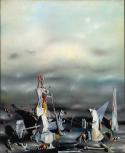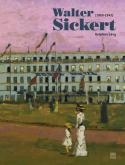Art Of The Day Weekly
#437 - from 30 June 2016 to 6 July 2016

Frédéric Bazille, Negress with Peonies, oil on canvas, 1870, 60 x 75 cm, musée Fabre, Montpellier. © Photo Frédéric Jaulmes.
IN THE AIR
Bazille, an impressionist who died too young
MONTPELLIER – The cultivated public knows his name. He has his own admirers on the other side of the Atlantic with 4 paintings of this at the National Gallery in Washington D.C. He is also mentioned in art history books. But Frédéric Bazille, 1m90 tall, is rarely placed among the stars of impressionism. He could have reached the same glory as his friends Renoir and Monet had he not died on 28 November 1870, right before his 28th birthday, in his Zouave uniform during the war against Prussia. The large retrospective organised in his native Montpellier, where he belonged to the Protestant bourgeoisie, groups together the greater part of his production that does not amount to more than some fifty paintings. But we see the signs of Impressionism at its very beginnings, before the famous exhibition in 1874, in particular in his Réunion de famille, terrasse à Méric (Family portrait on the terrace in Méric), considered the first outdoor group portrait in French painting. La Pêche à l’épervier (Fisherman with a Net), la Robe rose (the Pink Dress), la Négresse aux pivoines (Negress with Peonies), his views of Aigues-Mortes are other great classics in the same genre. The well-timed donations by his family in 1898 and 1909 to the musée Fabre and to the Louvre (later transferred to the musée d’Orsay) helped save his work from oblivion. And new discoveries occur, as with a painting he presented to the jury of the Salon in 1866, la Jeune Fille au piano (Young girl at the piano), long believed to be lost, has been found. An x-ray detected it under a Bible composition dedicated to Ruth and Booz.
• Frédéric Bazille, la jeunesse de l’impressionnisme, at musée Fabre, from 25 June to 16 October 2016. Catalogue Flammarion, €45.
EXHIBITIONS

Yves Tanguy, Le Palais aux rochers de fenêtres, 1942, oil on canvas, 163 x 132 cm, Centre Pompidou, Paris. ©Centre Pompidou, MNAM-CCI, Dist. RMN-Grand Palais / all rights reserved © ADAGP, Paris, 2016
Tanguy-Ernst, the dual
SÈTE – We know the roads to Surrealism are fathomless and it is not easy to compare them. The exhibition places side by side two major icons of the movement - Max Ernst and Yves Tanguy -, with the simple intention of confronting the paths of two childhood friends, taken up in the upheaval of the 20th century. They were side by side as early as 1925, one was a friend of Dalí’s and Eluard’s, the other was part of the delirious group of rue du Château in Paris, with Queneau and the Prévert brothers. Both artists immigrated to the USA where they continued to see each other until the early death of Tanguy in 1955, and each had his own distinctive, easily identifiable universe. Fantastic butterflies, collages, rubbings, one with a lasting taste for mockery (Papillon contribuable) while the other likes wide pale plains peopled with soft figures, but have a common taste for petrified landscapes … Many of these works come from the fund of art dealer David Nahmad, and some of them have been rarely exhibited.
• Max Ernst, Yves Tanguy, deux visions du surréalisme at the musée Paul Valéry, from 25 June to 6 November 2016. Catalogue Editions midi-pyrénéennes, €38.
AS WELL AS...
Spain's Golden Age
BERLIN – The Gemäldegalerie presents a portrait of the most brilliant period in Spanish art, the XVIIth century. It has brought out pieces from its own collection of Spanish masters, such as Velázquez and Pereda, enriching it with loans from the Prado or the National Museum of sculpture in Valladolid. This is truly the Golden Century, with such great masters as Zurbarán, Ribera and the skilful wood sculptors.
• The Age of Velázquez at the la Gemaldegalerie, from 1 July to 30 October 2016.
The heroes of Baselitz
FRANKFURT - His figures, either upwards or upside down, have a monumental force and dimension that are never better shown than in his Héros series. It dates from the 60’s but is shown her for the first time complete. In the midst of the German miracle, only twenty years after the end of the war, Georg Baselitz (born in 1938) ironically questioned the persistence of the superman myth.
• Georg Baselitz, The Heroes at the Städel Museum, from 30 June to 23 October 2016.
Von Stuck and Vienna
VIENNA - Franz von Stuck (1863-1928) a year older and Klimt’s ego, contributed to blast Conventions in imperial Vienna with his subversive eroticism. The exhibition traces the relations between this artist from Munich and the emblematic city of the Secession, which started when he was only twenty years old and drew book covers for editors.
• Sin and Secession, Franz Von Stuck in Vienna at the Belvedere, from 1 July to 9 October 2016.
PHOTOGRAPHY

João Pina, series Absurde. Esteban Echeverría, Argentina, September 2011. With the artist's kind authorisation.
Arles, the 47th edition
ARLES - When they baptised it in 1970, historian Rouquette, writer Tournier and photographer Clergue probably did not imagine the Rencontres photographiques d’Arles would live on. The success is due of course to the growing role photogrpahy plays in our daily lives, to its introduction in museums. In face of a universal custom that pushes us to photograph sales tags, book covers or exhibition posters, photographers have more than ever a word to say. Next to the photo-paper pads, they can tell real stories, and sometimes over the long run. This is the theme rightly chosen for this edition. It is illustrated by authors such as Yan Morvan (born in 1954 with a long experience at Paris-Match and at the Sipa news agency), who went across the planet to build up an encyclopedia of the battle fields, or young João Pina (born in 1980), who investigated during a decade the sinister Condor plan, the repressive joint-venture of South American dictatorships during the 70s.
• Rencontres de la photographie at Arles, from 4 July to 25 September 2016.
BOOKS
Sickert, the secrets of the Belle Epoque
His genealogy is more dramatic than all of his paintings: Walter Sickert (1860-1942) descended from Danish painters, an English astronomist and an alcoholic Irish dancer. This Londoner born in Munich spent a good part of his life in France and long stays in Venice. All these elements explain his empathy for his brother and his staunch position as a European. He was a friend of Degas, of Blanche and of Wilde, he is curious about all manifestations of modern and urban life - shop owners, workers, music-hall dancers, prostitutes, the high society of horse races and sea resorts. He was a link between Impressionism and the avant-gards, but today he is forgotten in spite of a -brief- return to fame due to the thesis on him by Jack the Ripper. Best-seller author Patricia Cornwell defended it in particular, and she bought dozens of his works to carry out her investigation. The exhibition, open until 25 September 2016 at the castle-museum of his favorite city, Dieppe, reminds all visitors that fortunately many of his works are still available.
• Walter Sickert, by Delphine Lévy, Somogy art publisher, 2016, 152 p. , €28.
OPENINGS OF THE WEEK

STÉPHANIE SOLINAS - Dominique Lambert
5 July 2016 - ARLES - Carré d'art
A surprising composite drawing of the 191 Dominique Lamberts in the phone book
IN BRIEF
LONDON - The ancient art fair, Masterpiece London, will be held from 30 June to 6 July 2016.
MILANO - The General Assembly of the ICOM (International museum Council) will be held from 3 to 9 July 2016.
NANTES - The cultural event "Le Voyage à Nantes" will be held from 1 July to 28 August 2016.
VALLAURIS - The 24th International Biennal of ceramics is held from 2 July to 31 October 2016.

